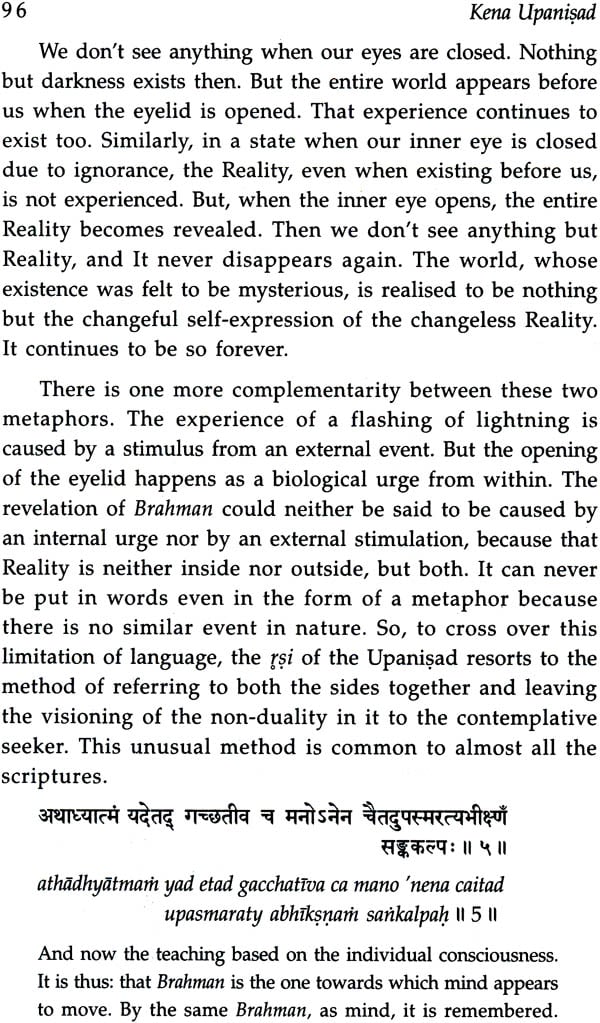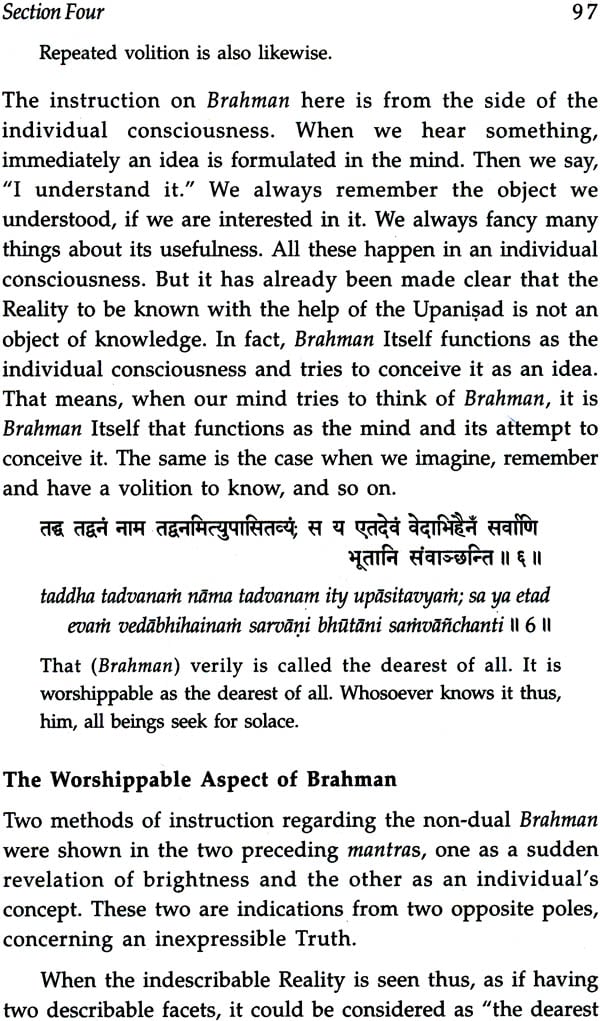
Kena Upanisad (Sanskrit Text, Transliteration, Translation and Detailed Commentary )
Book Specification
| Item Code: | IDF277 |
| Author: | Swami Muni Narayana Prasad |
| Publisher: | D. K. Printworld Pvt. Ltd. |
| Language: | Sanskrit Text, Transliteration, Translation and Detailed Commentary |
| Edition: | 2004 |
| ISBN: | 8124600341 |
| Pages: | 132 |
| Cover: | Paperback |
| Other Details | 8.4" X 5.4" |
| Weight | 220 gm |
Book Description
Kenopanisad is one of the major Upanisads containing the quintessence of the teachings of the ancient Indian seers. It represents their spiritual quest to apprehend the nature of the Ultimate Being and comprises the yearning for the wisdom that explains the relation of human life of the world and the reality. The beauty of this Upanisad is greatly enhanced by the dialogue between the disciple and the preceptor, through which it continues its quest.
Swami Muni Narayan Prasad, the renowned scholar of the Upanisadic tradition, renders a superbly novel analysis of this difficult text in the light of the modern man's need for the value and spiritual security making a strikingly beautiful synthesis between the ancient and the modern. Presenting the teachings of Kenopanisad in the backdrop of the recent developments in the area of physics, chemistry, biology and psychology is no mean task and continues the exclusiveness of this book. The disciplines of science in the pursuit of the basic truth stumble at some invisible and unconceptualisable Reality, which may be another name for mysticism. Through very cogent arguments the author has successfully vindicated that mysticism is a corollary to scientific investigation and not opposed to it.
The author's prolonged association with the Upanisadic thought along with the insight he received from the works of his preceptors, Narayana Guru and Nataraja Guru, makes the commentaries of this text stimulating and unique. The original Sanskrit text along with the Roman transliteration and English paraphrasing enhance the value of this monumental commentary.
About the Author:
Swami Muni Narayana Prasad is presently Head of the Narayana Gurukula, a guru-disciple foundation set up by Nataraja Guru, the disciple-successor of Narayana Guru. He has spent three years in Fiji teaching Indian philosophy and has traveled round the world giving classes. Became a disciple of Nataraja Guru in 1960 and was initiated as a renunciate in 1984. His published works in English include, Karma and Reincarnation - The Vedantic Perspective; Basic Lessons of India's Wisdom; Vedanta Sutras of Narayana Guru; Commentaries on the Katha, Mundaka, Prasna, Taittiriya and Aitareya Upanisads.
THE most interesting item of the daily routine of life in the Gurukula, ever since I became an inmate of it, had been the early morning recitation of the selected portions of the Upanisads. Eventually I began to explain the meaning of them to the kids in a simple way. Finally when I decided to lead the life of a renunciate, the special direction given by my Guru, Nataraja Guru, was that my sannyasa-life should be centred round the Upanisads and their tradition.
My main interest has always been on the philosophy of Narayana Guru who had attained final samndhi before I was born. My acquaintance with him was only through his highly philosophical poems as interpreted by Nataraja Guru based on the dialectical way of approach, which had been known to the ancient rsis of India as yoga-buddhi, as is evident from the Bhagavad-gita. Swami Aryabhatan, one of the well-known orators in the Malayalam language on spiritual matters, once told me that Narayana Guru once asked him to give lectures expounding the Upanisads in his own way. The Guru gave this direction when he met Swami Aryabhatan in his younger days as a talented orator. This gave me the courage to interpret the Upanisads in my own way. Narayana Guru's philosophy gave me an insight into many of the puzzling passages in the Upanisads,
I took up the Katha upanisad for giving a free interpretation, and my intention was not of writing a publishable book. My aspiration was to delve deep into the philosophy of the Upanisad as I was convinced that there was no other way of doing it. It was well received by readers on serializing in the Malayalam philosophical monthly, The Gurukulam. Then Guru Nitya Chaitanya Yati and self together resolved to write commentaries on all the ten major Upanisads, the Brhadaranyaka and Chandogya to be done by him and the rest by me. But he had already written his commentary on the Isa and Mandukya Upanisads by then. I therefore actually had to do only the remaining six. That is how this series originated.
I wrote the commentaries originally in Malayalam, my mother tongue. My interpretation of the Katha upanisad was translated to English and was serialised in the Gurukulam Quarterly published from the United States. When I found that it was well received, I dared to make the English version of the others too.
Excepting the Katha Upanisad and the Mundaka Upanisad all were originally written as a result of the collective thinking of a group of research scholars who were residing with me at the Gurukula. I am indebted to all of them. I made the English version of the Kena Upanisad, while I was living in Fiji, a small island country in South Pacific, where I had enough spare time to concentrate on such works.
The trustees of the Gita Ashram in Fiji were also much helpful. Dr Peter Oppenheimer of the USA took all the trouble to go through the entire text carefully and to edit it. I am grateful to all of them. I am also thankful to M/s D.K. Printworld for including my commentaries in their series "Rediscovering Indian Literary Classics."
With prostrations at the feet of both Narayana Guru and Nataraja Guru as well as the unknown rsis of yore, I offer this commentary on the Kena Upanisad as a forerunner to a new tradition of freely interpreting the scriptures of India, while adhering strictly to the essence of their comprehensive yet unitive philosophical vision.
| PREFACE | V |
| INTRODUCTION | 1 |
| SECTION ONE | 7 |
| SECTION TWO | 35 |
| SECTION THREE | 61 |
| SECTION FOUR | 81 |
| GLOSSARY | 103 |
| BIBLIOGRAPHY | 115 |
| INDEX | 119 |







